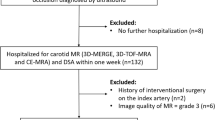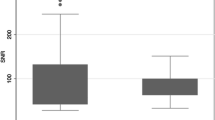Abstract
Purpose
Recently, various magnetic resonance imaging (MRI) modalities have been developed to easily detect carotid and aortic plaques, but these techniques are time-consuming and vulnerable to motion artifacts. We investigated the utility of a gradient echo MRI technique known as liver acquisition with volume acceleration flexible (LAVA-Flex) to detect carotid and aortic atherosclerotic plaques.
Methods
Ten patients who underwent carotid endarterectomy (CEA) were assessed regarding the correspondence between LAVA-Flex findings and the histopathology of excised carotid plaques. In addition, 47 patients with cryptogenic ischemic stroke underwent LAVA-Flex and transesophageal echocardiography (TEE) for detection of embolic sources in the thoracic aorta. We analyzed the relationship between the thickness of the aortic plaque measured by TEE and the presence of high-intensity lesions on LAVA-Flex.
Results
Nine of 10 patients (90.0%) who underwent CEA showed a high-intensity carotid lesion on LAVA-Flex, which corresponded pathologically to plaques containing large lipid cores and hemorrhage. Twenty-four (51.1%) of 47 cryptogenic stroke patients showed a high-intensity lesion in the thoracic aorta on LAVA-Flex; of these, 21 (87.5%) also demonstrated a large plaque (thickness ≥4 mm) on TEE. Twenty-two (95.7%) of 23 patients without a high-intensity lesion on LAVA-Flex demonstrated no large plaque on TEE. LAVA-Flex had a sensitivity of 95.5% and a specificity of 88.0% in patients with large plaques.
Conclusion
This study showed that LAVA-Flex successfully detected carotid and aortic plaques. This imaging technique may be useful to rapidly diagnose and evaluate carotid and aortic plaques, which are critical risk factors for aortogenic stroke.




Similar content being viewed by others
References
Amarenco P, Duyckaerts C, Tzourio C, Henin D, Bousser MG, Hauw JJ (1992) The prevalence of ulcerated plaques in the aortic arch in patients with stroke. N Engl J Med 326(4):221–225. https://doi.org/10.1056/NEJM199201233260402
Di Tullio MR, Russo C, Jin Z, Sacco RL, Mohr JP, Homma S, Patent foramen ovale in cryptogenic stroke study I (2009) aortic arch plaques and risk of recurrent stroke and death. Circulation 119 (17):2376-2382. https://doi.org/10.1161/CIRCULATIONAHA.108.811935
Tunick PA, Rosenzweig BP, Katz ES, Freedberg RS, Perez JL, Kronzon I (1994) High risk for vascular events in patients with protruding aortic atheromas: A prospective study. J Am College Cardiol 23(5):1085–1090. https://doi.org/10.1016/0735-1097(94)90595-9
Sugioka K, Matsumura Y, Hozumi T, Fujita S, Ito A, Kataoka T, Takagi M, Mizutani K, Naruko T, Hosono M, Hirai H, Sasaki Y, Ueda M, Suehiro S, Yoshiyama M (2011) Relation of aortic arch complex plaques to risk of cerebral infarction in patients with aortic stenosis. Am J Cardiol 108(7):1002–1007. https://doi.org/10.1016/j.amjcard.2011.05.036
Toyoda K, Yasaka M, Nagata S, Yamaguchi T (1992) Aortogenic embolic stroke: a transesophageal echocardiographic approach. Stroke 23(8):1056–1061. https://doi.org/10.1161/01.str.23.8.1056
Handa N, Matsumoto M, Maeda H, Hougaku H, Kamada T (1995) Ischemic stroke events and carotid atherosclerosis. Results of the Osaka Follow-up Study for Ultrasonographic Assessment of Carotid Atherosclerosis (the OSACA Study). Stroke 26(10):1781–1786. https://doi.org/10.1161/01.str.26.10.1781
Fayad ZA, Nahar T, Fallon JT, Goldman M, Aguinaldo JG, Badimon JJ, Shinnar M, Chesebro JH, Fuster V (2000) In vivo magnetic resonance evaluation of atherosclerotic plaques in the human thoracic aorta: a comparison with transesophageal echocardiography. Circulation 101(21):2503–2509. https://doi.org/10.1161/01.cir.101.21.2503
Eikendal AL, Blomberg BA, Haaring C, Saam T, van der Geest RJ, Visser F, Bots ML, den Ruijter HM, Hoefer IE, Leiner T (2016) 3D black blood VISTA vessel wall cardiovascular magnetic resonance of the thoracic aorta wall in young, healthy adults: reproducibility and implications for efficacy trial sample sizes: a cross-sectional study. J Cardiovasc Magn Reson 18:20. https://doi.org/10.1186/s12968-016-0237-2
Zhou C, Qiao H, He L, Yuan C, Chen H, Zhang Q, Li R, Wang W, Du F, Li C, Zhao X (2016) Characterization of atherosclerotic disease in thoracic aorta: A 3D, multicontrast vessel wall imaging study. Eur J Radiol 85(11):2030–2035. https://doi.org/10.1016/j.ejrad.2016.09.006
Hinton DP, Cury RC, Chan RC, Wald LL, Sherwood JB, Furie KL, Pitts JT, Schmitt F (2006) Bright and black blood imaging of the carotid bifurcation at 3.0T. Eur J Radiol 57(3):403–411. https://doi.org/10.1016/j.ejrad.2005.12.028
Oyama N, Gona P, Salton CJ, Chuang ML, Jhaveri RR, Blease SJ, Manning AR, Lahiri M, Botnar RM, Levy D, Larson MG, O'Donnell CJ, Manning WJ (2008) Differential impact of age, sex, and hypertension on aortic atherosclerosis: the Framingham Heart Study. Arterioscler Thromb Vasc Biol 28(1):155–159. https://doi.org/10.1161/ATVBAHA.107.153544
Li XH, Zhu J, Zhang XM, Ji YF, Chen TW, Huang XH, Yang L, Zeng NL (2014) Abdominal MRI at 3.0 T: LAVA-Flex compared with conventional fat suppression T1-weighted images. J Magn Reson Imaging 40(1):58–66. https://doi.org/10.1002/jmri.24329
Saito S, Tanaka K, Hashido T (2016) Liver acquisition with volume acceleration flex on 70-cm wide-bore and 60-cm conventional-bore 3.0-T MRI. Radiol Phys Technol 9(2):154–160. https://doi.org/10.1007/s12194-015-0344-z
Ma J (2004) Breath-hold water and fat imaging using a dual-echo two-point Dixon technique with an efficient and robust phase-correction algorithm. Magn Reson Med 52(2):415–419. https://doi.org/10.1002/mrm.20146
Beddy P, Rangarajan RD, Kataoka M, Moyle P, Graves MJ, Sala E (2011) T1-weighted fat-suppressed imaging of the pelvis with a dual-echo Dixon technique: initial clinical experience. Radiology 258(2):583–589. https://doi.org/10.1148/radiol.10100912
Irie R, Amemiya S, Ueyama T, Suzuki Y, Kamiya K, Takao H, Mori H, Abe O (2020) Accelerated acquisition of carotid MR angiography using 3D gradient-echo imaging with two-point Dixon. Neuroradiology 62(10):1345–1349. https://doi.org/10.1007/s00234-020-02452-6
Yuan C, Mitsumori LM, Ferguson MS, Polissar NL, Echelard D, Ortiz G, Small R, Davies JW, Kerwin WS, Hatsukami TS (2001) In vivo accuracy of multispectral magnetic resonance imaging for identifying lipid-rich necrotic cores and intraplaque hemorrhage in advanced human carotid plaques. Circulation 104(17):2051–2056. https://doi.org/10.1161/hc4201.097839
Shimada Y, Ueno Y, Tanaka Y, Okuzumi A, Miyamoto N, Yamashiro K, Tanaka R, Hattori N, Urabe T (2013) Aging, aortic arch calcification, and multiple brain infarcts are associated with aortogenic brain embolism. Cerebrovasc Dis 35(3):282–290. https://doi.org/10.1159/000347073
Watanabe Y, Nagayama M (2010) MR plaque imaging of the carotid artery. Neuroradiology 52(4):253–274. https://doi.org/10.1007/s00234-010-0663-z
Orrapin S, Rerkasem K (2017) Carotid endarterectomy for symptomatic carotid stenosis. Cochrane Database Syst Rev 6:CD001081. https://doi.org/10.1002/14651858.CD001081.pub3
Saito A, Sasaki M, Ogasawara K, Kobayashi M, Hitomi J, Narumi S, Ohba H, Yamaguchi M, Kudo K, Terayama Y (2012) Carotid plaque signal differences among four kinds of T1-weighted magnetic resonance imaging techniques: a histopathological correlation study. Neuroradiology 54(11):1187–1194. https://doi.org/10.1007/s00234-012-1025-9
Narumi S, Sasaki M, Ohba H, Ogasawara K, Hitomi J, Mori K, Ohura K, Ono A, Terayama Y (2010) Altered carotid plaque signal among different repetition times on T1-weighted magnetic resonance plaque imaging with self-navigated radial-scan technique. Neuroradiology 52(4):285–290. https://doi.org/10.1007/s00234-009-0642-4
Sato Y, Ogasawara K, Narumi S, Sasaki M, Saito A, Tsushima E, Namba T, Kobayashi M, Yoshida K, Terayama Y, Ogawa A (2016) Optimal MR Plaque Imaging for Cervical Carotid Artery Stenosis in Predicting the Development of Microembolic Signals during Exposure of Carotid Arteries in Endarterectomy: Comparison of 4 T1-Weighted Imaging Techniques. AJNR Am J Neuroradiol 37(6):1146–1154. https://doi.org/10.3174/ajnr.A4674
Yamaguchi Y, Tanaka T, Morita Y, Yoshimura S, Koga M, Ihara M, Toyoda K (2019) Associations of High Intensities on Magnetization-Prepared Rapid Acquisition with Gradient Echo with Aortic Complicated Lesions in Ischemic Stroke Patients. Cerebrovasc Dis 47(1-2):15–23. https://doi.org/10.1159/000497068
Harloff A, Brendecke SM, Simon J, Assefa D, Wallis W, Helbing T, Weber J, Frydrychowicz A, Vach W, Weiller C, Markl M (2012) 3D MRI provides improved visualization and detection of aortic arch plaques compared to transesophageal echocardiography. J Magn Reson Imaging 36(3):604–611. https://doi.org/10.1002/jmri.23679
Availability of data and material
Not applicable
Code availability
Not applicable
Author information
Authors and Affiliations
Contributions
K.Morihara, T.N., and F.T. contributed to conception and study design. K. Morihara, T.N., K. Mori, I.F., M.N., K.S., K.H., and M.T. contributed to acquisition and analysis of data. H.T., H.D., Y.K., and F.T. advised the interpretation of data. K. Morihara and F.T. contributed to drafting manuscript. All authors read and approved the final manuscript.
Corresponding author
Ethics declarations
Conflicts of interest
The authors declare no competing interests.
Ethical approval
All procedures performed in studies involving human participants were in accordance with the ethical standards of the institutional and/or national research committee and with the 1964 Helsinki declaration and its later amendments or comparable ethical standards.
Informed consent
For this type of study formal consent is not required
Additional information
Publisher’s note
Springer Nature remains neutral with regard to jurisdictional claims in published maps and institutional affiliations.
Rights and permissions
About this article
Cite this article
Morihara, K., Nakano, T., Mori, K. et al. Usefulness of rapid MR angiography using two-point Dixon for evaluating carotid and aortic plaques. Neuroradiology 64, 693–702 (2022). https://doi.org/10.1007/s00234-021-02812-w
Received:
Accepted:
Published:
Issue Date:
DOI: https://doi.org/10.1007/s00234-021-02812-w




